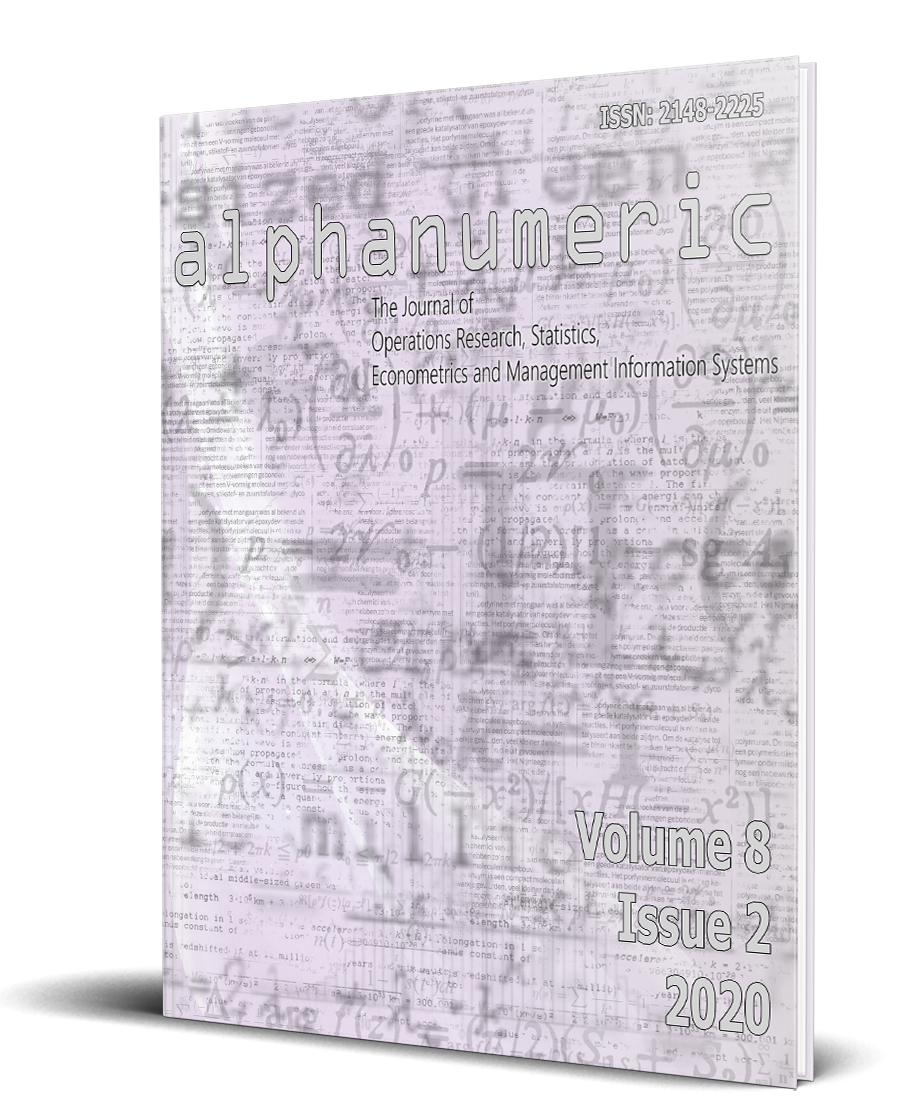
alphanumeric journal
The Journal of Operations Research, Statistics, Econometrics and Management Information Systems
An Application of the Generalized Poisson Model for Over Dispersion Data on The Number of Strikes Between 1984 and 2017
Abstract
Poisson regression analysis is widely used in many studies including count data. Poisson regression analysis is based on the assumption of equal mean and variance. However, this assumption is quite difficult in regression models. In cases where the assumption is not provided, over dispersion or under dispersion occurs. Over dispersion in data occurs when the variance of the dependent variable is greater than the average. This results in lower estimates than the standard errors. The generalized Poisson regression model is one of the methods used in case of over dispersion. This model is a generalization of Poisson regression. In this study, Poisson regression and generalized Poisson regression methods were used in the modelling of count data for determinants of strikes between 1984 and 2017. According to empirical results, while all explanatory variables of the Poisson regression model were significant, the unemployment rate was found to be insignificant for the generalized Poisson regression model. This result was evaluated considering the structure of the data.
Keywords: Count Data, Generalized Poisson Model, Over Dispersion, Strike Numbers
Jel Classification: C46
Suggested citation
(). An Application of the Generalized Poisson Model for Over Dispersion Data on The Number of Strikes Between 1984 and 2017. Alphanumeric Journal, 8(2), 249-260. http://dx.doi.org/10.17093/alphanumeric.670611
References
- Agresti, A. (1996). An Introduction to Categorical Data Analysis. John Wiley and Sons, New York.
- Akaike, H. (1973). Information Theory and an Extension of the Maximum Likelihood Principle, 2nd International Symposium on Information Theory, 267-281.
- Al-Ghirbal A.S. and Al-Ghamdi A.S. (2006). Predecting Severe Accidents Rates at Roundabouts Using Poisson Distribution. TRB Annual Meeting, 06-1684.
- Cameron, A.C. and Trivedi, P.K. (1998). Regression Analysis of Count Data. Cambridge University Press.
- Consul, P.C. and Jain G.C. (1973). A Generalization of The Poisson Distribution. Technometrics, 15(4), 791-799.
- Deniz Ö. (2005). Poisson Regresyon Analizi, İstanbul Ticaret Üniversitesi, Fen Bilimleri Dergisi, 4(7): 59-72.
- Famoye, F. (1993). Restricted Generalized Poisson Regression Model. Communications in Statistics Theory and Methods, 22(5), 1335-1354.
- Gujarati, D.F. (1999). Temel Ekonometri, Çev. Ümit Şenesen ve Gülay Günlük Şenesen, İstanbul: Literatür Yayıncılık.
- Hoffman, J. (2004). Generalized Linear Models, Boston, Pearson Education Inc.
- Hurvich, C.M. and Tsai, C. (1989). Regression and Time Series Model Selection in Small Samples, Biometrika, 76, 297-307.
- Joe, H. and Zhu, R. (2005). Generalized Poisson Distribution: The Property of Mixture of Poisson and Comparison with Negative Binomial Distribution, Biometrical Journal 47(2), 219‐229.
- Kibar, F.T. (2008). Trafik Kazaları ve Trabzon Bölünmüş Sahil Yolu Örneğinde Kaza Tahmin Modelinin Oluşturulması. Karadeniz Teknik Üniversitesi, Fen Bilimleri Enstitüsü, Yüksek Lisans Tezi.
- King, G. (1988). Statistical Models for Political Science Event Counts: Bias in Conventional Procedures and Evidence for the Exponential Poisson Regression Model, American Journal of Political Science, 3(3), 838-863.
- Koutsoyiannis A. (1989). Ekonometri Kuramı, Çev: Ümit Şenesen ve Gülay Günlük Şenesen, Ankara: Verso Yayıncılık.
- McQuarrie, A.D. and Tsai, C. L. (1998). Regression and Time Series Model Selection, World Sciencetific.
- Moksony, F. and Hegedus, R. (2014). The Use of Poisson Regression in the Sociological Study of Suicide, Corvinus Journal of Sociology And Social Policy, 5(2), 97-114.
- Osgood, D.W. (2000), Poisson-Based Regression Analysis of Aggregate Crime Rates, Journal of Quantitative Criminology, 16, 21-43.
- Pamukcu, E., Colak, C. and Halisdemir, N. (2014) Modeling of The Number of Divorce in Turkey Using The Generalized Poisson, Quasi-Poisson and Negative Binomial Regression, Turkish Journal of Science & Technology, 9(1), 89-96.
- Sezgin, F.H. and Deniz, E. (2004). Poisson Regresyon Modelinde Aşırı Yayılım Durumu ve Negatif Binomial Regresyon Analizinin Türkiye Grev Sayıları Üzerine Bir Uygulaması, Yönetim, 15(48), 17-25.
- Stata (2019). StataCorp, Statistical Software Package, Stata v.14. Erişim linki: https://www.stata.com/
- Sugiura, N. (1978). Further Analysis of the Data by Akaike’s Information Criterion and the Finite Corrections, Communication in Statistics Theory and Methods, 57, 13-26.
- Şahin, H. (2002). Poisson Regresyon Uygulaması: Türkiye'deki Grevlerin Belirleyicileri 1964-1998, Doğuş Üniversitesi Dergisi, 5, 173-180.
- Tokol, A. (2016). Türkiye’de Sendikal Hareket, Sendikacılık Akademisi Ders Notları-4. Erişim linki: http://www.turkis.org.tr/dosya/sqzeWfz7yWyS.pdf
- Yang, Z., Hardin, J.W. and Addy, C.L. (2009). A Score test for Overdispersion in Poisson Regression Based on The Generalized Poisson-2 Model, Journal of Statistical Planning and Inference. 139, 1514-1521.
2020.08.02.STAT.02
alphanumeric journal
Pages 249-260
Received: Jan. 6, 2020
Accepted: Sept. 22, 2020
Published: Dec. 31, 2020
2020 Durmuş, B., İşçi Güneri, Ö.
This is an Open Access article, licensed under Creative Commons Attribution-NonCommercial 4.0 International License.

scan QR code to access this article from your mobile device
Contact Us
Faculty of Transportation and Logistics, Istanbul University
Beyazit
Campus 34452 Fatih/Istanbul/Türkiye
Bahadır Fatih Yıldırım, Ph.D.
editor@alphanumericjournal.com
+ 90
(212) 440 00 00 - 13219
alphanumeric journal
alphanumeric journal has been publishing as "International Peer-Reviewed Journal" every six months since 2013. alphanumeric serves as a vehicle for researchers and practitioners in the field of quantitative methods, and is enabling a process of sharing in all fields related to the operations research, statistics, econometrics and management informations systems in order to enhance the quality on a globe scale.

